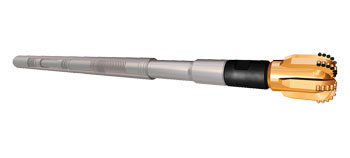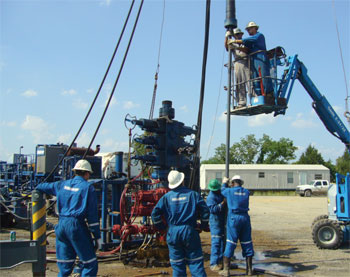Coiled
Tubing Technology
Anti-Stall Technology boosts the value of coiled tubing well intervention
A new way to prevent stalling in downhole drilling motors has been shown
to improve the efficiency of drilling and milling in oilwell applications.
Vibj�rn Dagestad, Statoil ASA, Nils
Reimers, Tomax AS, Katrine Eide and Magne
Mykkeltvedt,
PI-Intervention AS
Long horizontal wells were established as the best strategy for good
field economy on the Norwegian Continental Shelf in the early '90s.
The wells, however, required new intervention methods. Statoil turned
to Coiled Tubing (CT) as the primary option, but as the wells became
more advanced, friction made interventions troublesome and operations
with downhole motors costly and unpredictable. Simultaneously, Statoil
began looking for improvements in through-tubing technologies. One
such development was the Norwegian company Tomax AS's proprietary Anti-Stall
Technology (AST), Fig. 1.
 |
|
Fig. 1. AST is based on a telescopic tool placed anywhere in the BHA. The tool regulates the force on bit as a function of drilling torque transitions through an internal helical thread and absorber system.
|
|
CONCEPT
The concept is based on controlling drilling torque by regulating
the weight on bit to assist the driller attempting to do the same from
surface. Placed anywhere in the BHA, the new tool function prevents
stalls and extends the life of drilling tools through significant reductions
in vibration and shock.
In brief, the tool works as follows:
� When
the bit approaches stall, the quickly increasing torsion will activate
the tool, causing it to contract.
� This
contraction will offload the bit, which will then spin up to its
original speed.
� With
the bit back at full speed, the unit will gradually release accumulated
torsion.
� The
process can be repeated as often as necessary.
TESTING/QUALIFICATION
Statoil produced two identical prototypes for qualification tests
as a part of an internal through-tubing technology project. The program
included three shop/bench tests and eight full-scale offshore operations.
The tests confirmed tool function according to the theoretical background.
The first bench test was done with a 2 7/8-in. Weatherford drilling
motor.
First, a reference BHA was run without the anti-stall tool, and then
with the tool. The bench setup was intended to simulate poor weight
transfer where the BHA was jumped quickly forward and the bit rammed
into an obstruction. In this case, a metal ring represented the top
of a bridge plug. The feed was provided by air cylinders.
In the reference run, shock loads of about 0.5 kdaN (1,100 lb) were
enough to stall the motor. With the anti-stall tool included, the motor
did not stall even with the maximum available pressure and shock loads
of 2.4 kdaN (5,400 lb). Another, more surprising, observation was the
high rate of penetration that was produced when the motor was drilling
at 2.4 kdaN�about 1 in. in a total of 15 min. Comparing the pressure
gauges on the pumps with the output chart for the motor showed that,
while attempting to prevent the motor from stalling, the AST controlled
the motor differential pressure at high levels with an output close
to the maximum horsepower.
Bench observations showed that the anti-stall tool established a stable
state almost immediately after the bit engaged the obstruction. Also,
the accumulated torsion inside the tool was observed to balance constantly
against the bit torque; hence, the tool could be expected to keep the
bit on bottom. Measuring oil deposits on the telescopic surface showed
that axial movements were limited to an average of 2 mm and a maximum
of 5 mm, much smaller than the 5 in. available, and the bit appeared
to run at constant speed.
In terms of internal orientation, this equals about a 4° average
and a 12° maximum. The theoretical time to stabilize tool orientation
is the time the reactive pressure takes to reach the pump, which equals
the length of tubing multiplied by the speed of sound in fluid (about
5 sec. for 6,000 m).To test the AST's ability to stabilize the BHA
and its orientation, the bit was run into the obstruction without flow.
Pumps were then started with the bit on bottom. The AST reduced the
BHA length and the force on bit just enough to allow the motor to start
and accelerate to optimal speed. Again, the system used just a few
seconds to stabilize and produce good penetration.
FIELD OPERATIONS
The prototype tools were deployed to Ekofisk field and operator ConocoPhillips
to mill a long section of hard scale from a minimum drift of 13/4 in.
up to 4 in. Due to efficient penetration in the initial run, a planned
intermediate run was left out, and the second mill completed the job.
The Final Job Summary noted that the motor did not stall when milling
commenced. The anti-stall device was ordered for a second well from
the same platform. Again there was a sharp reduction in motor stalls.
Eight consecutive field deployments saw positive overall results: significant
reduction in stalls, low wear on CT and BHA, minimum fatigue cycles
on CT and jobs completed ahead of plan.
In the Norwegian sector, the new technology is improving CT campaigns.
Interventions with motor and mill are now often completed in one run.
AST has consequently become a part of the �Best Practices� operational
document for initial supporter Statoil. Other operators are also using
the technology on a permanent basis, and according to the service supplier,
the new technology was used for all CT drilling operations on the Norwegian
Continental Shelf, regardless of operator, by September 2006. At the
same time, 34 wells had been serviced worldwide using AST, and the
fleet was expanded to cover the full range of 111/16-in. to 43/4-in.
OD. The tool is now being tested for regular rotary drilling.
A set of tools was sent to Through Tubing Solutions Inc. in Oklahoma
City along with an AST field services specialist to evaluate the technology
for the US market. The first job was in the Fayetteville Shale, where
the tool was run to improve efficiency in drilling out composite bridge
plugs left after well stimulation. The anti-stall tool was run behind
a 27/8-in. motor and produced a reduction in stalls, Fig. 2. The field
operator has continued using the technology in challenging gas wells.
Another set of tools was sent to Canada for similar operations, and
the same efficiency improvement was produced.
 |
|
Fig.
2. Stabbing an AST above a 2 7/8-in. motor for the first
Fayetteville Shale job. |
|
ADDING RIG VALUE
An
overall observation from the Midwest and Canadian intervention specialists
was that the AST's ability to overcome the effects of friction and
doglegs could move the window for CT operations to wells previously
requiring a workover rig. Such an extension of CT capacity has been
the prime driver for engineering and improvement of AST since the first
operation. By analyzing tools received back from the field, the tools'
mechanical properties have been optimized. Further engineering and
simulations aim to reduce the effect of jarring on the tool in both
directions, using a pressurized fluid-transfer system like a modern
shock absorber, but one that will transmit high, fast impacts similar
to that of a hydraulic jar. At the same time, the system would dampen
less precise impacts and counteract natural frequencies resulting from
bit rotation.

|
THE
AUTHOR |
|
Vibj�rn Dagestad is staff engineer for through-tubing technology at Statoil ASA. He earned an MS in petroleum engineering from the University of Stavanger and has been with various field services companies before his present position. He can be contacted at: vidag@statoil.com
|
|
| |
Nils
Reimers is CEO of Tomax AS and co-inventor of the AST tool. He earned a BS in petroleum engineering from the University of Stavanger and comes from a position as vice president, Drilling Equipment at Aker Kvaerner. He can be contacted at: post@tomax.no
|
|
|
Katrine
Eide is director of Quality and HSE at PI-Intervention AS, where she also has been in charge of the commercial AST market introduction. She holds a BS in petroleum engineering from the University of Stavanger. She can be contacted at: ke@pi-intervention.com |
|
|
Magne
Mykkeltvedt is a sales and operations engineer for Downhole and Intervention Services with Weatherford. He can be contacted at: magne.mykkeltvedt@weatherford.com |
|
|





